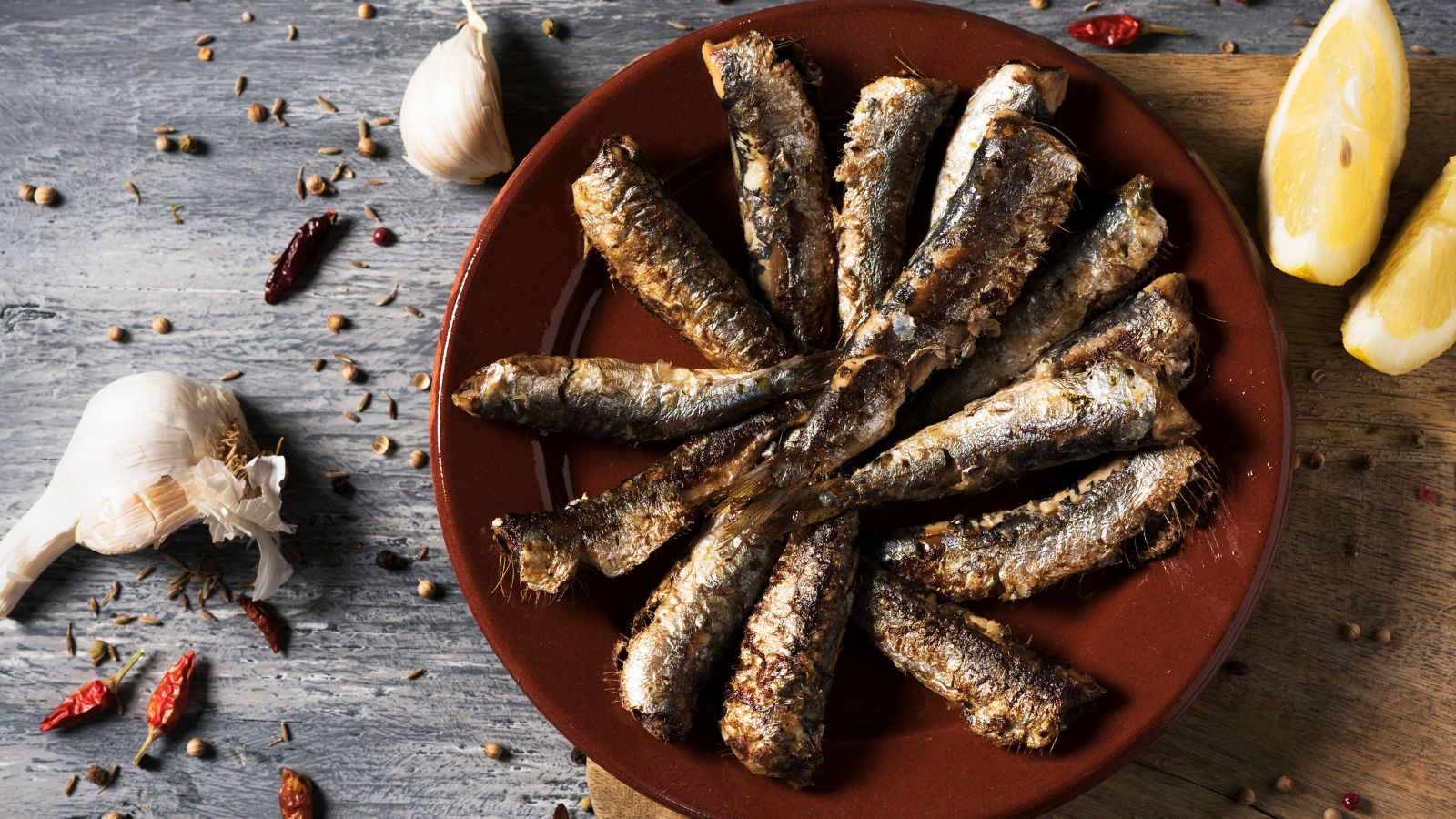
Can Dogs Eat Sardines in Olive Oil? Full Guide for Safe Feeding
Photo Credit: Canva Pro
Do you want to know if dogs can eat sardines in olive oil? No is the short answer. Occasionally, sardines in olive oil may be safe for dogs if the oil is drained and portions are small, but they are not ideal for regular feeding.
You will learn how to safely feed your dog sardines, how much to give, and why sardines that are packed in water are better. We'll also talk about other options and answer questions that dog owners often have.
Can Dogs Eat Sardines in Olive Oil?
Photo Credit: Canva Pro
There are many good things for dogs in sardines, but not all of them are safe for them. It might sound good to pack sardines in olive oil, but they have too much fat and can make your dog sick or make them gain weight. It’s better to feed dogs sardines that are canned in water, with no added salt or flavoring.
Why Sardines in Olive Oil Aren’t a Good Idea
When fed often, giving your dog oily fish with extra oil can hurt them more than help. While dogs don’t need excessive added fat, small amounts of olive oil can offer skin and digestive benefits when appropriately portioned.
-
Too much fat: Can lead to diarrhea, upset stomach, or even pancreatitis.
-
Extra calories: Dogs that don’t get much exercise may quickly gain weight.
-
Unnecessary oils: Dogs already get healthy fats from sardines alone.
-
Better options: Use fish oil or salmon oil if you want extra fatty acids.
Best Types of Sardines to Feed Your Dog
The type of sardines you use is important for your dog's health, whether you use fresh or canned ones.
-
Tinned sardines in water: The safest and most recommended option.
-
Avoid raw sardines: Raw sardines can carry parasites. Freeze at –4°F (–20°C) for at least 7 days before feeding to ensure safety.
-
Stay away from flavored versions: Sauces, spices, or brine are bad for dogs.
-
Cook plain if feeding fresh sardines: No oils or seasoning needed.
How Much Sardine Can a Dog Have?
Photo Credit: Canva Pro
Small amounts of sardines are good for dogs. Although sardines are high in protein and healthy fats, feeding sardines to your pet too often can throw off their diet. Part control is very important.
Safe Serving Size Based on Dog’s Weight
When adding sardines, it's best to start small. Watch how your dog responds, especially if he has stomach problems or allergies.
-
Small dogs (under 20 lbs): 1–2 sardines, once or twice weekly.
-
Medium dogs (20–50 lbs): Up to 3 sardines per serving.
-
Large dogs (over 50 lbs): 4–5 sardines per serving.
-
Feeding schedule: 1–2 times a week is enough—don’t overdo it.
What Happens If You Feed Too Many Sardines?
When eaten in large amounts, even healthy food can be bad. If you give your dog too many sardines, it can hurt its weight and gut.
-
Risk of mercury poisoning: Sardines are among the lowest mercury fish and are generally safe from mercury-related concerns when fed in typical portions.
-
Too much fat: It can lead to obesity and increase the risk of pancreatitis in dogs.
-
Digestive issues: Excess fish oil may cause loose stools or upset stomach.
-
Unbalanced meals: Dogs need more than just fatty fish to stay healthy.
What’s Better for Dogs: Tuna or Sardines?
Photo Credit: Canva Pro
When it comes to feeding your dog, sardines are better than tuna. They are cleaner, safer, and have more nutrients. There may be more mercury in tuna and fewer healthy fats. As a family member of herring family, sardines are much safer to feed for a long time.
Why Sardines Are Safer and Healthier
Without the high risk of toxins associated with tuna or other fish, sardines provide dogs with the nutrients they need.
-
Lower mercury risk: Sardines are small and low on the food chain.
-
More omega 3 fatty acids: Great for skin, joints, and a healthy coat.
-
High quality protein: Helps build strong muscles and supports body repair.
-
More vitamin D: Boosts bone health by improving calcium use.
What Sardines Offer That Tuna Doesn’t
A number of natural health benefits associated with canned sardines promote the general well-being of dogs.
-
Better digestion: Easier on the dog’s gut compared to raw fish or tuna.
-
Natural calcium source: From soft fish bones that are easy to eat.
-
No sharp bones: Most tinned sardines have edible, soft bones.
-
Full of nutrients: Ideal for a balanced diet when fed properly.
Can Dogs Eat Olive Oil on Its Own?
Photo Credit: Canva Pro
If you use olive oil the right way, it can be safe for dogs. It's good for you in many ways, but you should only use small amounts. Pet parents should be careful giving them new foods, especially if their dog already has a health condition or a sensitive stomach.
Health Benefits of Olive Oil for Dogs
When used in moderation, olive oil can help your skin, digestion, and weight loss. But it shouldn't be given to all dogs every day as a supplement.
-
Good for coat and skin: Helps relieve dryness and supports a shiny coat.
-
Supports digestion: May help with mild constipation by lubricating the digestive system.
-
Boosts antioxidants: Olive oil contains vitamin E which supports immune health.
-
Great for senior dogs: It may support brain and joint function in older pets.
When to Avoid Olive Oil
Most of the time, olive oil is safe, but it might not be best for all dogs. Watch your pet carefully whenever you give them something new to eat.
-
Dogs with sensitive stomachs: Can experience digestive upset like diarrhea.
-
Overweight dogs: Extra fat may slow weight loss or cause a dog sick with bloating.
-
Dogs with pancreatitis: High-fat oils can worsen the condition.
-
Feeding tip: Start with small amounts and never mix with oily fish like sardines in olive oil.
What Can FullyHealthy Offer Dog Owners?
FullyHealthy is a reliable online store that sells clean, healthy food. We sell sardines that are safe for dogs and good for pet owners who care about using good ingredients. Our products like Wild Sardines in EVOO are great for dogs that can't eat certain foods or are sensitive to them.
FullyHealthy Sardine Products
Everything they sell with sardines is caught in the wild and packed in organic extra virgin olive oil. You shouldn't feed your pet sardines in oil every day, but they can be a treat once in a while if they are drained properly.
-
Frozen sardines alternative: FullyHealthy's canned options offer long shelf life and convenience.
-
Hand-filleted quality: Helps reduce the chance of choking hazard from large bones.
-
Low-carb and clean: Free from fillers, artificial ingredients, and common allergens.
-
Sardines good for dogs: Rich in protein, omega-3s, and vitamins.
Why Shop from FullyHealthy?
Pet owners who care more about quality than quantity will like what FullyHealthy has to offer. Their sardines fit better than a lot of other treats or toppings for regular kibble.
-
Great for special diets: Ideal for dogs with food allergies or sensitive stomachs.
-
Balanced sourcing: Products are clean, ethical, and sourced from wild fish.
-
Safe bones: Products contain only small bones that are soft and generally safe.
-
Better than feeding raw: Compared to feed raw options, these are shelf-stable and controlled.
Final Thoughts
When served right, sardines are good for dogs. You should not eat sardines in olive oil. Instead, you should use canned sardines in spring water that has no salt added. Good protein, omega-3 fatty acids, and other nutrients that are good for your dog's health can be found in large amounts. Eat small amounts so that you don't get too much fat. Choose clean, simple foods that lower inflammation and help you eat a balanced diet, whether you use canned or frozen sardines.
Sardines shouldn't be fed instead of regular food, but they can be a healthy addition or a treat once in a while. You can get sardines that are safe for dogs from reliable sources like FullyHealthy and brands like Nature's Logic. Before introducing sardines to your dogs, you should always talk to your vet, especially if the dog is young or has a sensitive stomach.
FAQs
Are sardines good for dogs with sensitive stomachs?
Yes, sardines good if packed in spring water and given in small portion. Avoid sardines in oil or sauce to prevent digestive upset.
Can puppies eat sardines?
Yes, but puppies need small portion only. Make sure the bones are soft or removed. Canned sardines in spring water are safest.
Is the fat content in sardines bad for dogs?
Too much fat content can make a dog sick. That’s why sardines in olive oil or other oily fish should only be an occasional treat.
What’s better: sardines in spring water or olive oil?
Spring water is better. It has no added fat content and helps reduce inflammation while keeping sardines safe for feeding.
Is Nature's Logic sardines good for dogs?
Nature's Logic has sardines safe and high in protein. They’re good for bone health, reduce inflammation, and okay for puppies when given right.

Leave a comment